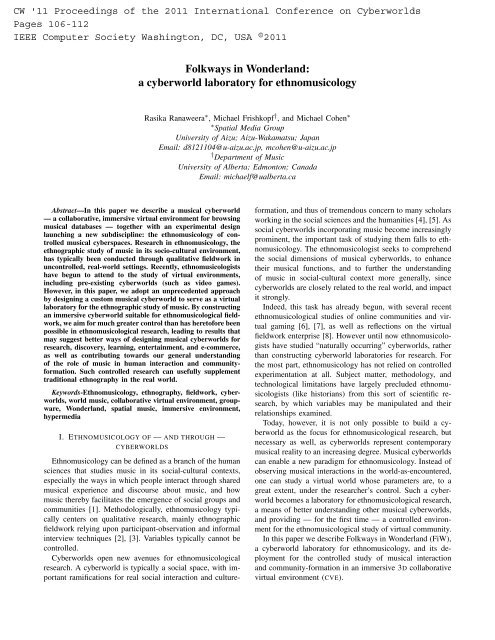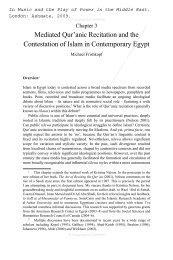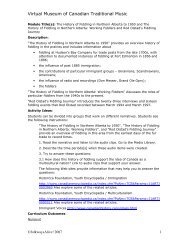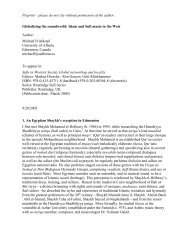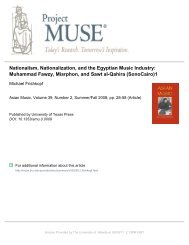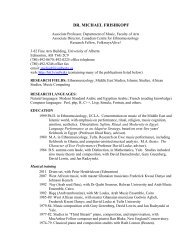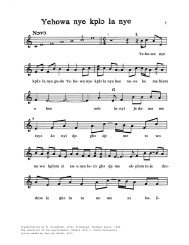a cyberworld laboratory for ethnomusicology - University of Alberta
a cyberworld laboratory for ethnomusicology - University of Alberta
a cyberworld laboratory for ethnomusicology - University of Alberta
Create successful ePaper yourself
Turn your PDF publications into a flip-book with our unique Google optimized e-Paper software.
Folkways in Wonderland:<br />
a <strong>cyberworld</strong> <strong>laboratory</strong> <strong>for</strong> <strong>ethnomusicology</strong><br />
Abstract—In this paper we describe a musical <strong>cyberworld</strong><br />
— a collaborative, immersive virtual environment <strong>for</strong> browsing<br />
musical databases — together with an experimental design<br />
launching a new subdiscipline: the <strong>ethnomusicology</strong> <strong>of</strong> controlled<br />
musical cyberspaces. Research in <strong>ethnomusicology</strong>, the<br />
ethnographic study <strong>of</strong> music in its socio-cultural environment,<br />
has typically been conducted through qualitative fieldwork in<br />
uncontrolled, real-world settings. Recently, ethnomusicologists<br />
have begun to attend to the study <strong>of</strong> virtual environments,<br />
including pre-existing <strong>cyberworld</strong>s (such as video games).<br />
However, in this paper, we adopt an unprecedented approach<br />
by designing a custom musical <strong>cyberworld</strong> to serve as a virtual<br />
<strong>laboratory</strong> <strong>for</strong> the ethnographic study <strong>of</strong> music. By constructing<br />
an immersive <strong>cyberworld</strong> suitable <strong>for</strong> ethnomusicological fieldwork,<br />
we aim <strong>for</strong> much greater control than has hereto<strong>for</strong>e been<br />
possible in ethnomusicological research, leading to results that<br />
may suggest better ways <strong>of</strong> designing musical <strong>cyberworld</strong>s <strong>for</strong><br />
research, discovery, learning, entertainment, and e-commerce,<br />
as well as contributing towards our general understanding<br />
<strong>of</strong> the role <strong>of</strong> music in human interaction and community<strong>for</strong>mation.<br />
Such controlled research can usefully supplement<br />
traditional ethnography in the real world.<br />
Keywords-Ethnomusicology, ethnography, fieldwork, <strong>cyberworld</strong>s,<br />
world music, collaborative virtual environment, groupware,<br />
Wonderland, spatial music, immersive environment,<br />
hypermedia<br />
I. ETHNOMUSICOLOGY OF — AND THROUGH —<br />
CYBERWORLDS<br />
Ethnomusicology can be defined as a branch <strong>of</strong> the human<br />
sciences that studies music in its social-cultural contexts,<br />
especially the ways in which people interact through shared<br />
musical experience and discourse about music, and how<br />
music thereby facilitates the emergence <strong>of</strong> social groups and<br />
communities [1]. Methodologically, <strong>ethnomusicology</strong> typically<br />
centers on qualitative research, mainly ethnographic<br />
fieldwork relying upon participant-observation and in<strong>for</strong>mal<br />
interview techniques [2], [3]. Variables typically cannot be<br />
controlled.<br />
Cyberworlds open new avenues <strong>for</strong> ethnomusicological<br />
research. A <strong>cyberworld</strong> is typically a social space, with important<br />
ramifications <strong>for</strong> real social interaction and culture-<br />
Rasika Ranaweera ∗ , Michael Frishkopf † , and Michael Cohen ∗<br />
∗ Spatial Media Group<br />
<strong>University</strong> <strong>of</strong> Aizu; Aizu-Wakamatsu; Japan<br />
Email: d8121104@u-aizu.ac.jp, mcohen@u-aizu.ac.jp<br />
† Department <strong>of</strong> Music<br />
<strong>University</strong> <strong>of</strong> <strong>Alberta</strong>; Edmonton; Canada<br />
Email: michaelf@ualberta.ca<br />
<strong>for</strong>mation, and thus <strong>of</strong> tremendous concern to many scholars<br />
working in the social sciences and the humanities [4], [5]. As<br />
social <strong>cyberworld</strong>s incorporating music become increasingly<br />
prominent, the important task <strong>of</strong> studying them falls to <strong>ethnomusicology</strong>.<br />
The ethnomusicologist seeks to comprehend<br />
the social dimensions <strong>of</strong> musical <strong>cyberworld</strong>s, to enhance<br />
their musical functions, and to further the understanding<br />
<strong>of</strong> music in social-cultural context more generally, since<br />
<strong>cyberworld</strong>s are closely related to the real world, and impact<br />
it strongly.<br />
Indeed, this task has already begun, with several recent<br />
ethnomusicological studies <strong>of</strong> online communities and virtual<br />
gaming [6], [7], as well as reflections on the virtual<br />
fieldwork enterprise [8]. However until now ethnomusicologists<br />
have studied “naturally occurring” <strong>cyberworld</strong>s, rather<br />
than constructing <strong>cyberworld</strong> laboratories <strong>for</strong> research. For<br />
the most part, <strong>ethnomusicology</strong> has not relied on controlled<br />
experimentation at all. Subject matter, methodology, and<br />
technological limitations have largely precluded ethnomusicologists<br />
(like historians) from this sort <strong>of</strong> scientific research,<br />
by which variables may be manipulated and their<br />
relationships examined.<br />
Today, however, it is not only possible to build a <strong>cyberworld</strong><br />
as the focus <strong>for</strong> ethnomusicological research, but<br />
necessary as well, as <strong>cyberworld</strong>s represent contemporary<br />
musical reality to an increasing degree. Musical <strong>cyberworld</strong>s<br />
can enable a new paradigm <strong>for</strong> <strong>ethnomusicology</strong>. Instead <strong>of</strong><br />
observing musical interactions in the world-as-encountered,<br />
one can study a virtual world whose parameters are, to a<br />
great extent, under the researcher’s control. Such a <strong>cyberworld</strong><br />
becomes a <strong>laboratory</strong> <strong>for</strong> ethnomusicological research,<br />
a means <strong>of</strong> better understanding other musical <strong>cyberworld</strong>s,<br />
and providing — <strong>for</strong> the first time — a controlled environment<br />
<strong>for</strong> the ethnomusicological study <strong>of</strong> virtual community.<br />
In this paper we describe Folkways in Wonderland (FiW),<br />
a <strong>cyberworld</strong> <strong>laboratory</strong> <strong>for</strong> <strong>ethnomusicology</strong>, and its deployment<br />
<strong>for</strong> the controlled study <strong>of</strong> musical interaction<br />
and community-<strong>for</strong>mation in an immersive 3D collaborative<br />
virtual environment (CVE).
(a) A discussion park enables quiet conversations among avatars populating<br />
the <strong>cyberworld</strong>.<br />
(c) Inside the cylindrical map, showing West Africa. Tracks are represented<br />
by colored dots.<br />
II. BROWSING MUSIC DATABASES THROUGH AN<br />
IMMERSIVE CYBERWORLD<br />
As immersive 3D virtual environments and online music<br />
networks become increasingly popular, it behooves<br />
researchers to explore their convergence: groupware music<br />
browsers populated by figurative avatars. Using Open<br />
Wonderland, 1 a Java open source toolkit <strong>for</strong> creating collaborative<br />
3D virtual worlds, we developed an immersive<br />
virtual environment (similar to the “Music in Wonderland”<br />
1 http://openwonderland.org<br />
(b) Exterior view <strong>of</strong> the cylindrical map<br />
(d) Collaborative listening. The red dot (located in Senegal, below the album<br />
cover) represents the track currently selected by our avatar (Rasika).<br />
Figure 1. Entering Folkways in Wonderland<br />
pro<strong>of</strong>-<strong>of</strong>-concept developed by Sun Microsystems) where<br />
user avatars can interact freely while browsing a musical<br />
database.<br />
Our <strong>cyberworld</strong> music browser comprises a cylinder upon<br />
which a rectangular map <strong>of</strong> the world is texture mapped.<br />
Musical tracks are geotagged (according to location <strong>of</strong><br />
per<strong>for</strong>mance, per<strong>for</strong>mers, or style), and a track marker<br />
(a red or orange dot) is appropriately positioned on the<br />
map at the correct latitude and longitude. This marker is<br />
simultaneously a sound source, a virtual stereo speaker that
Figure 2. In the upper-center window, the user browses metadata <strong>for</strong> the track (located in Puerto Rico) selected in the left window; buttons allow the<br />
user to view liner notes; listen via virtual headphones (excluding competing sounds); locate the track on the Smithsonian Folkways website; teleport to the<br />
track; search <strong>for</strong> other tracks; or view track location on a zoomable Google map (upper right). The user may also embark on a tour using the lower right<br />
window.<br />
loops the corresponding audio track, enabling location-aware<br />
multisensory browsing. Multiple avatars can enter the space,<br />
listen to these virtual speakers, and contribute their own<br />
sounds (typically speech) to the mix via voice chat [9].<br />
Avatars hear all sound sources (tracks, and sounds produced<br />
by other avatars) within the space, attenuated <strong>for</strong> distance,<br />
and combined according to a spatial sound engine that<br />
emulates real-world binaural hearing. (See Figure 1.)<br />
Avatars are free to explore the <strong>cyberworld</strong>, using keyboard<br />
and mouse controls to navigate throughout the cylinder, and<br />
in the surrounding virtual environment (including a building,<br />
and a verdant park), while interacting with one another and<br />
listening to music. Wonderland supports multiple perspectives,<br />
including endocentric (1 st person) and egocentric (2 nd<br />
person) points <strong>of</strong> view. While inside the cylinder, a user may<br />
click a marker to select a particular track (only one track may<br />
be selected at a time, <strong>for</strong> each avatar). The selected marker<br />
changes color (from orange to red), the track’s album cover<br />
appears above the marker, and its metadata is displayed in<br />
a separate window, together with a Google map providing<br />
detailed, zoomable, topographic in<strong>for</strong>mation. Buttons are<br />
available allowing the avatar to teleport to the selected<br />
track’s location, to don virtual headphones connected to this<br />
track (in order to exclude competing sounds), to search <strong>for</strong><br />
other tracks by metadata (users may teleport to a search<br />
result by clicking), or to purchase a track. Liner notes may<br />
be downloaded as a PDF file. (See Figure 2.)<br />
Avatars can also join any one <strong>of</strong> several configurable<br />
tours, which automatically leads them through a sequence<br />
<strong>of</strong> tracks in a predefined order. While visiting a particular<br />
track its metadata is displayed; the visiting period is userconfigurable,<br />
and users can also elect to leave the tour at any<br />
time. In addition, two track lists can be displayed: a playlist<br />
containing the complete track population, and a track history<br />
listing tracks that have been visited in the current session.<br />
Items on either list may be clicked to teleport directly to the<br />
selected track.<br />
The system is collaborative, since multiple users can<br />
hear music together, as well as hear and see each other,<br />
communicating through speech and text-chat. Wonderland<br />
also provides in-world collaborative applications, such as a<br />
shared web browser or whiteboard. Thus users are provided<br />
with a realtime, immersive, audio-visual representation <strong>of</strong><br />
their virtual social environment.<br />
III. FOLKWAYS IN WONDERLAND<br />
Our musical <strong>cyberworld</strong> is called “Folkways in Wonderland”<br />
(FiW) because it is populated with track samples<br />
from Folkways Recordings, founded by Moses Asch and<br />
Marian Distler in 1948, directed by Asch until his death in
Sever Component (Managed Object)<br />
FiWCellMO<br />
Spatialize Audio | Receive/Send from/to Client<br />
Server<br />
XML Music Database Parser<br />
FiWTrackInfoParser<br />
Metadata (Title, Artist, ...) | Geo (Lat, Lon) | Resources (URL)<br />
Client<br />
Initialize Client Components<br />
FiWCellRenderer<br />
Browser Cylinder | Placemarks | Center Hut<br />
Place Tracks | Pass Info to Render Graphics | Init Dialogs<br />
Control & Display Dialogs and Functions<br />
MetadataDialog<br />
General | Notational | Audio<br />
Metadata | Teleport | History | Narrowcast | Multipresence*<br />
Create Audio Treatment<br />
MapDialog<br />
Lat. | Lon. | Country<br />
Voice Manager, Spatializer<br />
Treatment Type | FullVolumeRadius | Extent | FallOff | Attenuator<br />
Setup Treatment | Create Treatment<br />
Graphics Renderer<br />
jMonkeyEngine<br />
Graphics | Animation | Geometry | SceneGraph | Renderer<br />
World Map | Album Frames | Flare Animation<br />
OWLClient<br />
2<br />
High-fidelity Audio<br />
Audio Manager Client<br />
Stereo Sound | Voice Chat<br />
Delay Effect | Proximity | Distance Attenuation<br />
SearchDialog<br />
Artist | Album | Genre | Country<br />
TourDialog<br />
jVoiceBridge<br />
World Music Tour<br />
Figure 3. FiW System Schematic: An OpenWonderlandClient (OWLClient) connects to the server <strong>for</strong> simple client messaging among other clients, while<br />
audio mixing is done at jVoiceBridge, which is built into the Wonderland server. The FiWCellMO server (top left) generates a list <strong>of</strong> track samples by<br />
parsing an XML database using a common FiWTrackInfoParser when the server starts up. A Spatializer (top right) creates spatialized audio<br />
<strong>for</strong> the track list and VoiceManager is responsible <strong>for</strong> handling communication between clients. An AudioManagerClient at the client provides<br />
stereo audio <strong>for</strong> the client. FiWCellRenderer (left lower center), also using FiWTrackInfoParser (left upper center), generates the list <strong>of</strong> track<br />
samples at the client side. The generated track list is used <strong>for</strong> rendering track markers with JME, displaying metadata <strong>of</strong> a selected track, and searching<br />
<strong>for</strong> a particular keyword. The FiWCellRenderer is also responsible <strong>for</strong> rendering Java2D Swing dialogs including Metadata, Map, Search, and Tour.<br />
1986, and thereafter published and curated by Smithsonian<br />
Folkways, 2 the non-pr<strong>of</strong>it record label <strong>of</strong> the Smithsonian<br />
Institution, located in Washington D.C. During Asch’s remarkably<br />
productive tenure, the Folkways label produced<br />
2,168 albums containing over 40,000 tracks representing a<br />
stunningly diverse gamut <strong>of</strong> recorded sound from around<br />
the world, including musical, spoken, and environmental.<br />
Since acquiring the label in 1987, Smithsonian Folkways<br />
has expanded and digitized the Folkways collection, while<br />
enhancing and organizing its metadata, all <strong>of</strong> which is<br />
now available electronically. The Folkways collection thus<br />
<strong>of</strong>fers a number <strong>of</strong> distinct advantages: it is large, diverse,<br />
global, well-documented, and digital. Furthermore, it is, in<br />
itself, one <strong>of</strong> the most important and enduring products <strong>of</strong><br />
ethnomusicological research ever assembled.<br />
From the full Folkways collection, we have selected, encoded,<br />
and geotagged a set <strong>of</strong> 1,166 music tracks, carefully<br />
2 http://www.folkways.si.edu<br />
chosen <strong>for</strong> aesthetic and cultural interest and geographical<br />
distribution, to represent the full spectrum <strong>of</strong> world music.<br />
Out <strong>of</strong> this set only several dozen populate the FiW <strong>cyberworld</strong><br />
at any one time; the selection <strong>of</strong> track population<br />
is easily configurable, as track pointers, geotags, and other<br />
metadata are all stored in an XML file.<br />
IV. ARCHITECTURE & IMPLEMENTATION<br />
Wonderland uses a client-server model with various networking<br />
protocols <strong>for</strong> different data types [10]. TCP is<br />
used <strong>for</strong> communicating object properties and positions,<br />
while SIP & RTP are used <strong>for</strong> audio communication. The<br />
Wonderland server consists <strong>of</strong> several services that can be<br />
distributed across multiple machines to increase scalability.<br />
The web administration server provides authentication.<br />
The Darkstar server provides a plat<strong>for</strong>m <strong>for</strong> Wonderland<br />
to track the frequently updated states <strong>of</strong> objects in the<br />
world. JVoiceBridge, communicating with Darkstar directly,<br />
is responsible <strong>for</strong> providing server-side mixing <strong>of</strong> immersive
audio. The Wonderland client acts as a browser <strong>for</strong> different<br />
Wonderland servers. FiW has been developed as a module<br />
in Wonderland, which is the mechanism <strong>for</strong> packaging,<br />
including objects, and adding new functionalities. A module<br />
consists <strong>of</strong> server code, which is installed in the Darkstar<br />
server, and client code, which is made available to clients.<br />
The system architecture is diagrammed in Figure 3. In<br />
the following sections, we highlight a number <strong>of</strong> design<br />
considerations.<br />
A. Arranging Music Tracks in 3D Space<br />
FiW enables music browsing in a multidimensional multimedia<br />
CVE rather than through textual lists, enabling a<br />
sonic, spatial, and social experience. We propose the cylinder<br />
as a structure well-suited <strong>for</strong> representing collections in<br />
collaborative 3D spaces. From a user perspective the cylinder<br />
provides a readily navigable structure onto which symbolic<br />
representations <strong>of</strong> collection content can be easily mapped.<br />
Since Wonderland does not currently permit recumbency, a<br />
virtual sphere, limiting angle <strong>of</strong> view near the poles, is not<br />
suitable.<br />
The music browser is, there<strong>for</strong>e, a cylinder upon which<br />
a rectangular world map is texture mapped. In general,<br />
flat maps are derived by projecting a sphere onto a plane,<br />
with associated trans<strong>for</strong>mation <strong>of</strong> spherical to rectilinear<br />
coordinates. A flat map can preserve only certain features<br />
<strong>of</strong> the sphere (e.g. direction, distance, area, or shape),<br />
while necessarily distorting others. We selected the Mercator<br />
projection, a rectangular map preserving rhumb lines but distorting<br />
distances and areas, especially near the poles. While<br />
modern cartographers have rightly critiqued this projection,<br />
the cylinder necessitates a rectangular map. The Mercator<br />
projection also harmonizes with Google Maps [11], with<br />
which we hope to immersively integrate in a future release.<br />
Finally, as few Folkways tracks are geotagged near the<br />
polar regions, Mercator distortions do not affect the spatial<br />
representation <strong>of</strong> music too adversely.<br />
B. Cell Renderer and Scenegraph Architecture<br />
Cell Renderers in Wonderland facilitate the ability to<br />
create visual representations <strong>of</strong> cells using jME (jMonkey<br />
Engine), a high per<strong>for</strong>mance scenegraph-based graphics<br />
API. 3 Each jME Cell Renderer provides a scene graph which<br />
is added as a child <strong>of</strong> an “attach point” node in the Cell<br />
Renderer <strong>of</strong> its parent cell, so each child cell can inherit its<br />
rendering state from the parent scene graph.The populated<br />
cylinder is a geometric 3D model rendered by jME; music<br />
tracks are children nodes <strong>of</strong> the cylinder. Each track is also<br />
a 3D model with the album cover image set as the texture<br />
when the corresponding marker is clicked, and positioned<br />
according to its geotag (latitude and longitude).<br />
3 http://www.jmonkeyengine.com<br />
aSinθ<br />
aθ<br />
θ<br />
θ<br />
θ<br />
aSinθ<br />
Figure 4. Woodworth’s Formula: Assume round head <strong>of</strong> radius a and<br />
speed <strong>of</strong> sound c. Then sound from a distant source travels extra distance<br />
a(θ +sin θ) to reach the contralateral ear. When θ = 0, ITD= 0, and when<br />
θ = π a π<br />
, ITD= ( + 1). Thus, the ITD vanishes when a source is directly<br />
2 c 2<br />
ahead, and reaches a maximum when the source is directly to one side.<br />
C. Sound Localization in Wonderland<br />
Sound localization refers to a listener’s ability to judge<br />
a sound’s source location, including distance and direction<br />
[12], [13], [14], [15]. ITD (Interaural Time Difference) is the<br />
difference in arrival time <strong>of</strong> a sound between two ears, as<br />
the sound arrives at an ipsilateral ear be<strong>for</strong>e the contralateral,<br />
since it must travel an extra distance around the head (see<br />
Eq. 1 and Figure 4).<br />
IT D = a<br />
π<br />
(θ + sin θ), −π ≤ θ ≤ (1)<br />
c 2 2<br />
FiW, providing stereophonic (2 channel) audio communication,<br />
supports users’ sound localization through two kinds<br />
<strong>of</strong> audio spatialization: (1) amplitude attenuation, suggesting<br />
distance; (2) interaural delay, suggesting direction. These<br />
effects are computed on the server side by an “Audio<br />
Treatment” component in the VoiceBridge. Two interleaved<br />
channels are sent in each packet, one delayed by 0–0.63 ms<br />
(Eq. 2), depending on the location <strong>of</strong> the source relative to<br />
the avatar.<br />
Approximating head radius as 0.08 m and the speed <strong>of</strong><br />
sound as 300 m/s, maximum ITD can be estimated as<br />
IT D ≈ 0.08<br />
300 (π<br />
2 + 1) ≈ 0.2<br />
300 ≈ 0.6 ms. (2)<br />
By per<strong>for</strong>ming spatialization on the server, it is possible<br />
to mix many audio sources appropriately <strong>for</strong> each avatar,<br />
while also reducing required bandwidth with more than<br />
four avatars. Letting n be the number <strong>of</strong> avatars populating<br />
FiW, the linear function (Eq. 3), representing bandwidth<br />
required <strong>for</strong> client–server mode, exceeds that required <strong>for</strong><br />
peer-to-peer mode (Eq. 4) when n < 4. However, when<br />
n > 4, peer-to-peer mode starts requiring more bandwidth<br />
than client–server mode (as shown in Figure 5), indicating
Figure 5. Client–Server (solid line) vs. Peer-to-Peer (dashed)<br />
the reduction <strong>of</strong> network usage when spatialization is<br />
per<strong>for</strong>med at the server side, since quadratic functions grow<br />
faster than linear.<br />
Client–Server:<br />
1 upstream + 2 downstream = 3n : O(n) (3)<br />
Peer-to-Peer:<br />
D. Navigation<br />
Many → many = n(n − 1) : O(n 2 ) (4)<br />
Besides basic movement functions (moving <strong>for</strong>ward or<br />
backward, stepping left or right, and turning), Wonderland<br />
allows each avatar to run, fly, and teleport, and to look<br />
up or down, via keyboard and mouse controls. One can<br />
also change one’s point <strong>of</strong> view, including first person<br />
(endocentric), front camera, and chase camera (egocentric).<br />
V. EXPERIMENTAL DESIGN<br />
Using Folkways in Wonderland as a virtual <strong>laboratory</strong>,<br />
we pose the following question: how do social actors, represented<br />
by avatars, interact in such an immersive <strong>cyberworld</strong>,<br />
when presented with a specific collaborative task? What<br />
sorts <strong>of</strong> virtual social groups and communities <strong>of</strong> taste<br />
emerge through virtual world music interactions, and how do<br />
these depend on the kinds <strong>of</strong> music and actors populating the<br />
<strong>cyberworld</strong>? A <strong>laboratory</strong> environment enables us to control<br />
variables to an unprecedented extent, and thus answer — at<br />
least within this restricted environment — questions about<br />
such dependencies with a rigor that cannot be achieved in the<br />
real world. In particular, we are concerned with two primary<br />
clusters <strong>of</strong> independent variables known by ethnomusicologists<br />
to shape the emergence <strong>of</strong> musical community: the<br />
social and the musical. Here, social variables include the<br />
number and demographic pr<strong>of</strong>iles <strong>of</strong> participants populating<br />
the <strong>cyberworld</strong>, while musical variables include the number<br />
and kinds <strong>of</strong> music tracks populating the <strong>cyberworld</strong>.<br />
Variables within either cluster can be manipulated: the<br />
<strong>for</strong>mer through participant selection; the latter by loading<br />
different collections <strong>of</strong> music tracks into Folkways in Wonderland.<br />
Participants are selected from among a volunteer<br />
adult population, subject to in<strong>for</strong>med consent and the availability<br />
<strong>of</strong> a common language <strong>for</strong> communication. Prior to<br />
entering the space, each subject is pr<strong>of</strong>iled, by recording age,<br />
gender, educational level and specialization, musical tastes<br />
and abilities, and ethnic background(s), all considered as<br />
variables within the social cluster. Divergences in musical<br />
taste and ethnic background are particularly important, as<br />
they are hypothesized to be key factors in the emergence <strong>of</strong><br />
social groups.<br />
Participants are directed to enter the <strong>cyberworld</strong> simultaneously<br />
during a prescribed two-hour-long period, in order<br />
to carry out a collective task: they are asked to learn as much<br />
as possible about the tracks embedded in the cylindrical<br />
map, decide which ones they prefer and why, then work<br />
together with other <strong>cyberworld</strong> denizens <strong>for</strong> the remainder<br />
<strong>of</strong> the period to assemble a partially-ranked list, the goal<br />
being to reach as much agreement as possible in ranking as<br />
many tracks as possible (in order <strong>of</strong> preference) within the<br />
allotted time.<br />
The criteria <strong>for</strong> the ranking (aesthetic power, musical<br />
preference, geocultural interest, recording quality, etc.) are<br />
left open, to be negotiated among the virtual participants,<br />
who must attempt to reach consensus regarding both criteria<br />
and rankings. In this way participants are <strong>for</strong>ced to interact<br />
on the basis <strong>of</strong> musical experience. At the conclusion <strong>of</strong><br />
the experiment, each participant is asked to submit a report<br />
detailing the ranking and explaining the criteria used.<br />
One <strong>of</strong> the participants is a cyber-ethnomusicologist from<br />
the research team, participating in, and observing, social<br />
interactions among avatars in FiW, and reporting on the<br />
processes <strong>of</strong> community <strong>for</strong>mation by means <strong>of</strong> traditional<br />
ethnomusicological tools, especially ethnographic fieldnotes,<br />
and in<strong>for</strong>mal unstructured interviews. For ethical reasons,<br />
the identity <strong>of</strong> the ethnomusicologist-participant will be<br />
disclosed. Such cyber-participant-observation is necessary<br />
to document and interpret the listening, communicating,<br />
and consensus-building processes, and also af<strong>for</strong>ds a novel<br />
approach to <strong>ethnomusicology</strong>.<br />
Analysis then proceeds as follows:<br />
• Clustering participants on the basis <strong>of</strong> their rankings,<br />
using theories <strong>of</strong> partially ranked data and rank aggregation<br />
(e.g. [16], [17]). Divergences between rankings<br />
indicate the emergence <strong>of</strong> subgroups, communities <strong>of</strong><br />
musical taste.<br />
• Thematic coding <strong>of</strong> qualitative research, namely the<br />
cyber-ethnomusicologist’s fieldnotes, and reports filed<br />
by other participants, followed by qualitative research<br />
analysis, in an attempt to understand the bases <strong>for</strong> consensus<br />
and the social processes leading to the <strong>for</strong>mation<br />
<strong>of</strong> subgroups.<br />
Research will at the outset be exploratory, but we anticipate<br />
that this preliminary phase will quickly lead to the<br />
<strong>for</strong>mulation <strong>of</strong> hypotheses and, subsequently, more focused<br />
experimentation designed to test them. We believe that
this process will produce results suggesting better ways<br />
<strong>of</strong> designing musical <strong>cyberworld</strong>s <strong>for</strong> research, discovery,<br />
learning, entertainment, and e-commerce, as well as indicating<br />
broader principles underlying the role <strong>of</strong> music in human<br />
interaction and community-<strong>for</strong>mation in general. In this way,<br />
controlled research in and about a custom-built musical<br />
<strong>cyberworld</strong> can usefully supplement, without supplanting,<br />
traditional real-world fieldwork in <strong>ethnomusicology</strong>.<br />
REFERENCES<br />
[1] B. Nettl, The Study <strong>of</strong> Ethnomusicology: Thirty-one issues<br />
and concepts. <strong>University</strong> <strong>of</strong> Illinois Press, 2005.<br />
[2] G. A. Fine, International Encyclopedia <strong>of</strong> the Social and<br />
Behavioral Sciences. Elsevier Science, 2001, ch. Participant<br />
Observation, pp. 11 073–11 078.<br />
[3] G. F. Barz and T. J. Cooley, Eds., Shadows in the Field:<br />
New Perspectives <strong>for</strong> Fieldwork in Ethnomusicology, 2nd ed.<br />
Ox<strong>for</strong>d <strong>University</strong> Press, 2008.<br />
[4] L. Kong, “Religion and technology: Refiguring place, space,<br />
identity and community,” Area, vol. 33, no. 4, pp. 404–413,<br />
Dec. 2001. [Online]. Available: http://www.jstor.org/stable/<br />
20004181<br />
[5] J. Taylor, “The emerging geographies <strong>of</strong> virtual worlds,”<br />
Geographical Review, vol. 87, no. 2, pp. 172–192, Apr.<br />
1997. [Online]. Available: http://www.jstor.org/stable/216004<br />
[6] R. T. A. Lysl<strong>of</strong>f, “Musical community on the internet:<br />
An on-line ethnography,” Cultural Anthropology, vol. 18,<br />
no. 2, pp. 233–263, May 2003. [Online]. Available:<br />
http://www.jstor.org/stable/3651522<br />
[7] K. Miller, “Jacking the dial: Radio, race, and place in<br />
”Grand theft auto”,” Ethnomusicology, vol. 51, no. 3, pp.<br />
402–438, Oct. 2007. [Online]. Available: http://www.jstor.<br />
org/stable/20174544<br />
[8] T. J. Cooley, K. Meizel, and N. Syed, Shadows in the Field:<br />
New Perspectives <strong>for</strong> Fieldwork in Ethnomusicology, 2nd ed.<br />
Ox<strong>for</strong>d <strong>University</strong> Press, 2008, ch. Virtual fieldwork: three<br />
case studies, pp. 90–107.<br />
[9] R. Ranaweera, M. Cohen, N. Nagel, and M. Frishkopf, “(virtual<br />
[world) music]: Virtual world, world music— Folkways<br />
in Wonderland,” in Int. Workshop on the Principles and<br />
Applications <strong>of</strong> Spatial Hearing, Zao, Miyagi, Japan, Nov.<br />
2009, www.riec.tohoku.ac.jp/IWPASH/Home.html.<br />
[10] J. Kaplan and N. Yankelovich, “Open wonderland: Extensible<br />
virtual world architecture,” IEEE Internet Computing, vol. 99,<br />
June 2011.<br />
[11] L. Shaomei, K. Yinghong, L. Haiyan, and A. Xiaoya, “Imagebased<br />
mapping using google earth images,” in Proc. ICACC:<br />
2nd Int. Conf. on Advanced Computer Control, vol. 5, Mar.<br />
2010, pp. 282–285.<br />
[12] D. R. Begault, 3-D Sound <strong>for</strong> Virtual Reality and Multimedia.<br />
Academic Press, 1994, ISBN 0-12-084735-3.<br />
[13] D. R. Begault, Ed., Spatial Sound Techniques, Part 1: Virtual<br />
and Binaural Audio Technologies. Audio Engineering<br />
Society, 2004, ISBN 0-937803-53-7.<br />
[14] F. Rumsey, Ed., Spatial Sound Techniques, Part 2: Multichannel<br />
Audio Technologies. Audio Engineering Society, 2006.<br />
[15] R. H. Gilkey and T. R. Anderson, Eds., Binaural and Spatial<br />
Hearing in Real and Virtual Environments. Lawrence<br />
Erlbaum Associates, 1997, ISBN 0-8058-1654-2.<br />
[16] D. E. Critchlow, Metric methods <strong>for</strong> analyzing partially<br />
ranked data. Springer, 1985.<br />
[17] S. Lin, “Rank aggregation methods,” WIREs Computational<br />
Statistics, vol. 2, September/October 2010.


